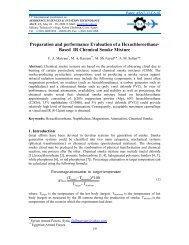Finite Element Modeling of Crushing Behaviour of Thin Tubes with ...
Finite Element Modeling of Crushing Behaviour of Thin Tubes with ...
Finite Element Modeling of Crushing Behaviour of Thin Tubes with ...
Create successful ePaper yourself
Turn your PDF publications into a flip-book with our unique Google optimized e-Paper software.
11/19<br />
Paper: ASAT-13-ST-34<br />
E 5.19 1.48cos[(0.05 Sb/ t)<br />
0.6]<br />
(1)<br />
where;<br />
E = Absorbed energy<br />
Sb = Side breadth,<br />
T = Tube thickness<br />
Initial Peak Load and Mean <strong>Crushing</strong> Force<br />
Figure (12) depicts the nonlinear relation between the increasing <strong>of</strong> the number <strong>of</strong> sides and<br />
the decreasing <strong>of</strong> the side breadth <strong>of</strong> a polygonal tube <strong>of</strong> 300mm perimeter. Variations <strong>of</strong> the<br />
initial peak load and mean crushing force <strong>with</strong> different number <strong>of</strong> sides (3-6) and various<br />
side breadths (50-100 mm) are shown in Figs. (13,14) for the polygonal tubes. Generally, it<br />
was observed that the initial peak load highly increased <strong>with</strong> the increasing <strong>of</strong> the number <strong>of</strong><br />
sides and greatly decreased <strong>with</strong> the increasing <strong>of</strong> the side breadth. Moreover, the initial peak<br />
loads <strong>of</strong> the triangular and square tubes had closed magnitudes while values <strong>of</strong> the initial peak<br />
loads <strong>of</strong> the pentagonal and hexagonal tubes were sharply far <strong>of</strong>f. On the other side, the mean<br />
crushing load was changed in a different manner <strong>with</strong> the number <strong>of</strong> sides and the side<br />
breadth <strong>of</strong> the tubes. The mean crushing load greatly decreased <strong>with</strong> the increasing <strong>of</strong> both the<br />
number <strong>of</strong> sides and the side breadth until reaching a minimum value at the square tube.<br />
Subsequently, the mean crushing load began to increase <strong>with</strong> the increasing <strong>of</strong> the number <strong>of</strong><br />
sides and the side breadth <strong>of</strong> the tubes. It is worth mentioning that the initial peak load and<br />
mean crushing force <strong>of</strong> the round (circular and elliptical) tubes were greatly higher than that<br />
obtained from the polygonal tubes as compared in Table (2).<br />
The Fold Depth and the Side Breadth <strong>of</strong> <strong>Tubes</strong><br />
The fold depth was investigated through a longitudinal path <strong>of</strong> the tube. This path was located<br />
at the middle <strong>of</strong> one arbitrary face for all the sided tubes. The fold depth <strong>of</strong> the sided tubes<br />
was compared <strong>with</strong> that obtained from the circular tube overall the tube span as shown in Fig.<br />
(15). The bottom end <strong>of</strong> all tubes was located at the origin <strong>of</strong> the horizontal axis, however the<br />
inward and/or outward fold pr<strong>of</strong>iles were recorded on the vertical axis <strong>of</strong> Fig. (15). It can be<br />
noticed that the folds <strong>of</strong> the circular tube have the lowest depth (approximately 8 mm) and<br />
bulged mainly outward. The pr<strong>of</strong>iles <strong>of</strong> all the folds are not so different except for the<br />
pentagonal tube where its fold pr<strong>of</strong>ile was not symmetric about the middle path. On the other<br />
side and apart from the triangular tube, the fold depth was seen maximum in the square tube<br />
and it generally decreased <strong>with</strong> increasing the number <strong>of</strong> sides <strong>of</strong> the polygonal tubes. In other<br />
words, starting from a polygonal tube <strong>with</strong> four sides, the initiated fold depth is decreased<br />
<strong>with</strong> the decreasing <strong>of</strong> the tube side breadth as depicted in Fig. (16). The relationship between<br />
the fold depth and the side breadth-to-thickness ratio <strong>of</strong> the tubes can be empirically<br />
expressed as:<br />
where;<br />
Fd = Fold depth,<br />
Sb = Side breadth,<br />
t = Tube thickness<br />
Fd 8.302exp[0.021( Sb / t)]<br />
(2)





